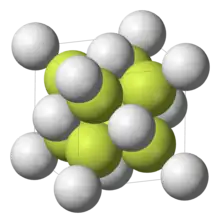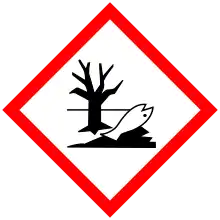Cadmium fluoride
Cadmium fluoride (CdF2) is a mostly water-insoluble source of cadmium used in oxygen-sensitive applications, such as the production of metallic alloys. In extremely low concentrations (ppm), this and other fluoride compounds are used in limited medical treatment protocols. Fluoride compounds also have significant uses in synthetic organic chemistry.[2] The standard enthalpy has been found to be -167.39 kcal. mole−1 and the Gibbs energy of formation has been found to be -155.4 kcal. mole−1, and the heat of sublimation was determined to be 76 kcal. mole−1.[3][4]
 | |
| Names | |
|---|---|
| IUPAC name
Cadmium fluoride | |
| Other names
Cadmium(II) fluoride, Cadmium difluoride | |
| Identifiers | |
3D model (JSmol) |
|
| ChemSpider | |
| ECHA InfoCard | 100.029.293 |
| EC Number |
|
PubChem CID |
|
| UNII | |
CompTox Dashboard (EPA) |
|
| |
| |
| Properties | |
| CdF2 | |
| Molar mass | 150.41 g/mol |
| Appearance | grey or white-grey crystals |
| Density | 6.33 g/cm3, solid |
| Melting point | 1,110 °C (2,030 °F; 1,380 K) |
| Boiling point | 1,748 °C (3,178 °F; 2,021 K) |
| 4.35 g/100 mL | |
| Solubility | soluble in acid insoluble in ethanol alcohol and liquid ammonia |
| -40.6·10−6 cm3/mol | |
| Structure | |
| Fluorite (cubic), cF12 | |
| Fm3m, No. 225 | |
| Thermochemistry | |
Std enthalpy of formation (ΔfH⦵298) |
-167.39 ± 0.23 kcal. mole-1 at 298.15 (K, C?) |
Gibbs free energy (ΔfG˚) |
-155.4 ± 0.3 kcal. mole-1 at 298.15 (K, C?) |
| Hazards | |
| GHS pictograms |    |
| GHS Signal word | Danger |
| H301, H330, H340, H350, H360, H372, H400, H410 | |
| P201, P202, P260, P264, P270, P271, P273, P281, P284, P301+310, P304+340, P308+313, P310, P314, P320, P321, P330, P391, P403+233, P405, P501 | |
| NIOSH (US health exposure limits): | |
PEL (Permissible) |
[1910.1027] TWA 0.005 mg/m3 (as Cd)[1] |
REL (Recommended) |
Ca[1] |
IDLH (Immediate danger) |
Ca [9 mg/m3 (as Cd)][1] |
| Related compounds | |
Other anions |
Cadmium chloride, Cadmium bromide Cadmium iodide |
Other cations |
Zinc fluoride, Mercury(II) fluoride, Copper(II) fluoride, Silver(II) fluoride, Calcium fluoride, Magnesium fluoride |
Except where otherwise noted, data are given for materials in their standard state (at 25 °C [77 °F], 100 kPa). | |
| Infobox references | |
Preparation
Cadmium fluoride is prepared by the reaction of gaseous fluorine or hydrogen fluoride with cadmium metal or its salts, such as the chloride, oxide, or sulfate.
It may also be obtained by dissolving cadmium carbonate in 40% hydrofluoric acid solution, evaporating the solution and drying in a vacuum at 150 °C.
Another method of preparing it is to mix cadmium chloride and ammonium fluoride solutions, followed by crystallization. The insoluble cadmium fluoride is filtered from solution.[5]
Cadmium fluoride has also been prepared by reacting fluorine with cadmium sulfide. This reaction happens very quickly and forms nearly pure fluoride at much lower temperatures than other reactions used.[6]
Uses
Electronic conductor
CdF2 can be transformed into an electronic conductor when doped with certain rare earth elements or yttrium and treated with cadmium vapor under high temperature conditions. This process creates blue crystals with varying absorption coefficients depending on the concentrations of the dopant. A proposed mechanism explains that the conductivity of these crystals can be explained by a reaction of Cd atoms with Interstitial F− ions. This creates more CdF2 molecules and releases electrons which are weakly bonded to trivalent dopant ions resulting in n-type conductivity and a hydrogenic donor level.[7]
Safety
Cadmium fluoride, like all cadmium compounds, is toxic and should be used with care.
Cadmium fluoride can cause potential health issues if it is not handled properly. It can cause irritation to the skin and the eyes, so gloves and protective eyewear are advised. The MSDS, or Material Safety Data Sheet, also includes warnings for ingestion and inhalation. Under acidic conditions, at high temperatures, and in moist environments, hydrogen fluoride and cadmium vapors may be released into the air. Inhalation may cause irritation of the respiratory system as well as congestion, fluorosis, and even pulmonary edema in extreme cases. Cadmium fluoride also has the same potential hazards caused by cadmium and fluoride.[8]
References
- NIOSH Pocket Guide to Chemical Hazards. "#0087". National Institute for Occupational Safety and Health (NIOSH).
- "Cadmium Fluoride". Retrieved 2009-06-06.
- Rudzitis, Edgars; Feder, Harold; Hubbard, Ward (November 1963). "Fluorine Bomb Calorimetry. VII. The Heat of Formation of Cadmium Difluoride". Journal of Physical Chemistry. 67 (11): 2388–2390. doi:10.1021/j100805a031.
- Besenbruch, G.; Kana'an, A. S.; Margrave, J. L. (March 3, 1965). "Knudson and Langmuir Measurements of the Sublimation Pressure of Cadmium (II) Fluoride". Journal of Physical Chemistry. 69 (9): 3174–3176. doi:10.1021/j100893a505.
- Pradyot Patnaik. Handbook of Inorganic Chemicals. McGraw-Hill, 2002, ISBN 0-07-049439-8
- Haendler, Helmut; Bernard, Walter (November 1951). "The Reaction of Fluorine with Cadmium and Some of its Binary Compounds. The Crystal Structure, Density and Melting Points of Cadmium Fluoride". Journal of the American Chemical Society. doi:10.1021/ja01155a064.
- Weller, Paul (June 1, 1965). "Electrical and Optical Properties of Rare Earth Doped Cadmium Fluoride Single Crystals". Inorganic Chemistry. 4 (11): 1545–1551. doi:10.1021/ic50033a004.
- "Cadmium Fluoride [CdF2]". MSDS Solutions Center. Advance Research Chemicals Inc. / A.R.C. 2011-04-01. Retrieved 2014-12-12.
External links
- National Pollutant Inventory - Cadmium and compounds fact sheet
- National Pollutant Inventory - Fluoride and compounds fact sheet